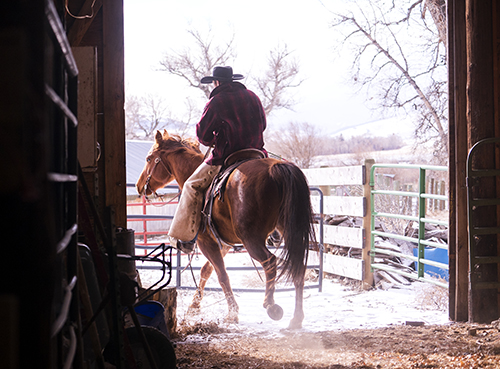Dewormers and Deworming Strategies
Jan 24, 2022

Over the last decade, the approach to deworming animals in animal agriculture has shifted from a time interval schedule to a strategic approach. For many years, animals were dewormed every three months, every six months, etc. As parasites have begun to develop resistance to the available dewormers on the market, a strategic approach became necessary. The prevailing theory among most parasitologists is that to reduce parasite resistance, the number of animals dewormed and the number of times they are dewormed must be reduced.
This strategy to deworm based on need has been most widely accepted in the small ruminant and equine industries. These two industries have seen the most parasite resistance and producers/owners often struggled to find a dewormer that was effective against the parasite their animals were carrying. The small ruminant industry implemented a deworming strategy known as FAMANCHA that was specifically designed to identify worm burdens in individual goats and sheep. Heavily parasitized animals were dewormed and good record-keeping allowed producers to cull individual animals that were chronically in the heavily parasitized category. In the equine industry, veterinarians switched from a rotational (using a different type of dewormer) and calendar-based approach to deworming horses based on their fecal egg shedding. Horses are evaluated for the number of parasite eggs in a fecal sample: high “shedders” are dewormed and low “shedders” are not. Horses may be evaluated several times a year and oftentimes, once a horse’s pattern is known, they may be dewormed according to history unless their management changes.
The cattle industry has taken a slightly different approach to the change in deworming. For the most part, all animals are still dewormed. However, more thought is given to the timing. For instance, in the southwest, most cattle are not heavily/often dewormed in the summer months since the weather patterns are too hot and dry for effective parasite transmission. Additionally, things like pasture contamination and pasture rotational strategies are considered before deciding to use dewormers. Finally, the use of pour-on endectocides for inexpensive fly control is highly discouraged and falling out of favor.
A few other concepts have been implemented to decrease unnecessary dewormer use. The first is related to the intensity of animal management. As a general rule, animals that are intensely managed (kept in confinement, maintained in high-density areas, etc.) have a higher need for more frequent deworming. Conversely, animals that are kept in range pasture situations where the density is low require less deworming. Secondly, thought is given to retaining animals that seem to have a natural resistance to parasitism, and animals that always seem to be “wormy” are encouraged to be culled. Finally, a deep and thorough understanding of dewormer classes is extremely effective in avoiding the perpetuation of parasite resistance. When a parasite develops a resistance to a specific dewormer, the parasite will likely be resistant to all dewormers in that class. Switching to a new dewormer from the same class only perpetuates the resistance; the switch must be to a dewormer in an entirely different class of dewormers to be effective in killing the parasites.
For more content like this, check out the latest issue of the Cooperator.
This strategy to deworm based on need has been most widely accepted in the small ruminant and equine industries. These two industries have seen the most parasite resistance and producers/owners often struggled to find a dewormer that was effective against the parasite their animals were carrying. The small ruminant industry implemented a deworming strategy known as FAMANCHA that was specifically designed to identify worm burdens in individual goats and sheep. Heavily parasitized animals were dewormed and good record-keeping allowed producers to cull individual animals that were chronically in the heavily parasitized category. In the equine industry, veterinarians switched from a rotational (using a different type of dewormer) and calendar-based approach to deworming horses based on their fecal egg shedding. Horses are evaluated for the number of parasite eggs in a fecal sample: high “shedders” are dewormed and low “shedders” are not. Horses may be evaluated several times a year and oftentimes, once a horse’s pattern is known, they may be dewormed according to history unless their management changes.
The cattle industry has taken a slightly different approach to the change in deworming. For the most part, all animals are still dewormed. However, more thought is given to the timing. For instance, in the southwest, most cattle are not heavily/often dewormed in the summer months since the weather patterns are too hot and dry for effective parasite transmission. Additionally, things like pasture contamination and pasture rotational strategies are considered before deciding to use dewormers. Finally, the use of pour-on endectocides for inexpensive fly control is highly discouraged and falling out of favor.
A few other concepts have been implemented to decrease unnecessary dewormer use. The first is related to the intensity of animal management. As a general rule, animals that are intensely managed (kept in confinement, maintained in high-density areas, etc.) have a higher need for more frequent deworming. Conversely, animals that are kept in range pasture situations where the density is low require less deworming. Secondly, thought is given to retaining animals that seem to have a natural resistance to parasitism, and animals that always seem to be “wormy” are encouraged to be culled. Finally, a deep and thorough understanding of dewormer classes is extremely effective in avoiding the perpetuation of parasite resistance. When a parasite develops a resistance to a specific dewormer, the parasite will likely be resistant to all dewormers in that class. Switching to a new dewormer from the same class only perpetuates the resistance; the switch must be to a dewormer in an entirely different class of dewormers to be effective in killing the parasites.
For more content like this, check out the latest issue of the Cooperator.